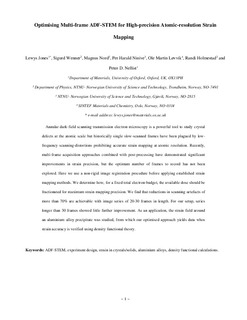| dc.contributor.author | Jones, Lewys | |
| dc.contributor.author | Wenner, Sigurd | |
| dc.contributor.author | Nord, Magnus Kristofer | |
| dc.contributor.author | Ninive, Per Harald | |
| dc.contributor.author | Løvvik, Ole Martin | |
| dc.contributor.author | Holmestad, Randi | |
| dc.contributor.author | Nellist, P.D. | |
| dc.date.accessioned | 2017-12-01T08:36:13Z | |
| dc.date.available | 2017-12-01T08:36:13Z | |
| dc.date.created | 2017-04-24T07:46:44Z | |
| dc.date.issued | 2017 | |
| dc.identifier.citation | Ultramicroscopy. 2017, 179 57-62. | nb_NO |
| dc.identifier.issn | 0304-3991 | |
| dc.identifier.uri | http://hdl.handle.net/11250/2468692 | |
| dc.description.abstract | Annular dark-field scanning transmission electron microscopy is a powerful tool to study crystal defects at the atomic scale but historically single slow-scanned frames have been plagued by low-frequency scanning-distortions prohibiting accurate strain mapping at atomic resolution. Recently, multi-frame acquisition approaches combined with post-processing have demonstrated significant improvements in strain precision, but the optimum number of frames to record has not been explored. Here we use a non-rigid image registration procedure before applying established strain mapping methods. We determine how, for a fixed total electron-budget, the available dose should be fractionated for maximum strain mapping precision. We find that reductions in scanning-artefacts of more than 70% are achievable with image series of 20–30 frames in length. For our setup, series longer than 30 frames showed little further improvement. As an application, the strain field around an aluminium alloy precipitate was studied, from which our optimised approach yields data whos strain accuracy is verified using density functional theory. | nb_NO |
| dc.language.iso | eng | nb_NO |
| dc.publisher | Elsevier | nb_NO |
| dc.rights | Attribution-NonCommercial-NoDerivatives 4.0 Internasjonal | * |
| dc.rights.uri | http://creativecommons.org/licenses/by-nc-nd/4.0/deed.no | * |
| dc.title | Optimising multi-frame ADF-STEM for high-precision atomic-resolution strain mapping | nb_NO |
| dc.type | Journal article | nb_NO |
| dc.type | Peer reviewed | nb_NO |
| dc.description.version | acceptedVersion | nb_NO |
| dc.source.pagenumber | 57-62 | nb_NO |
| dc.source.volume | 179 | nb_NO |
| dc.source.journal | Ultramicroscopy | nb_NO |
| dc.identifier.doi | 10.1016/j.ultramic.2017.04.007 | |
| dc.identifier.cristin | 1466108 | |
| dc.relation.project | Norges forskningsråd: 221714 | nb_NO |
| dc.relation.project | NORTEM: 197405 | nb_NO |
| dc.description.localcode | © 2017. This is the authors’ accepted and refereed manuscript to the article. LOCKED until 15.4.2019 due to copyright restrictions. This manuscript version is made available under the CC-BY-NC-ND 4.0 license http://creativecommons.org/licenses/by-nc-nd/4.0/ | nb_NO |
| cristin.unitcode | 194,66,20,0 | |
| cristin.unitcode | 194,18,25,30 | |
| cristin.unitname | Institutt for fysikk | |
| cristin.unitname | Seksjon for bygg, geomatikk og realfag | |
| cristin.ispublished | true | |
| cristin.fulltext | original | |
| cristin.qualitycode | 1 | |

